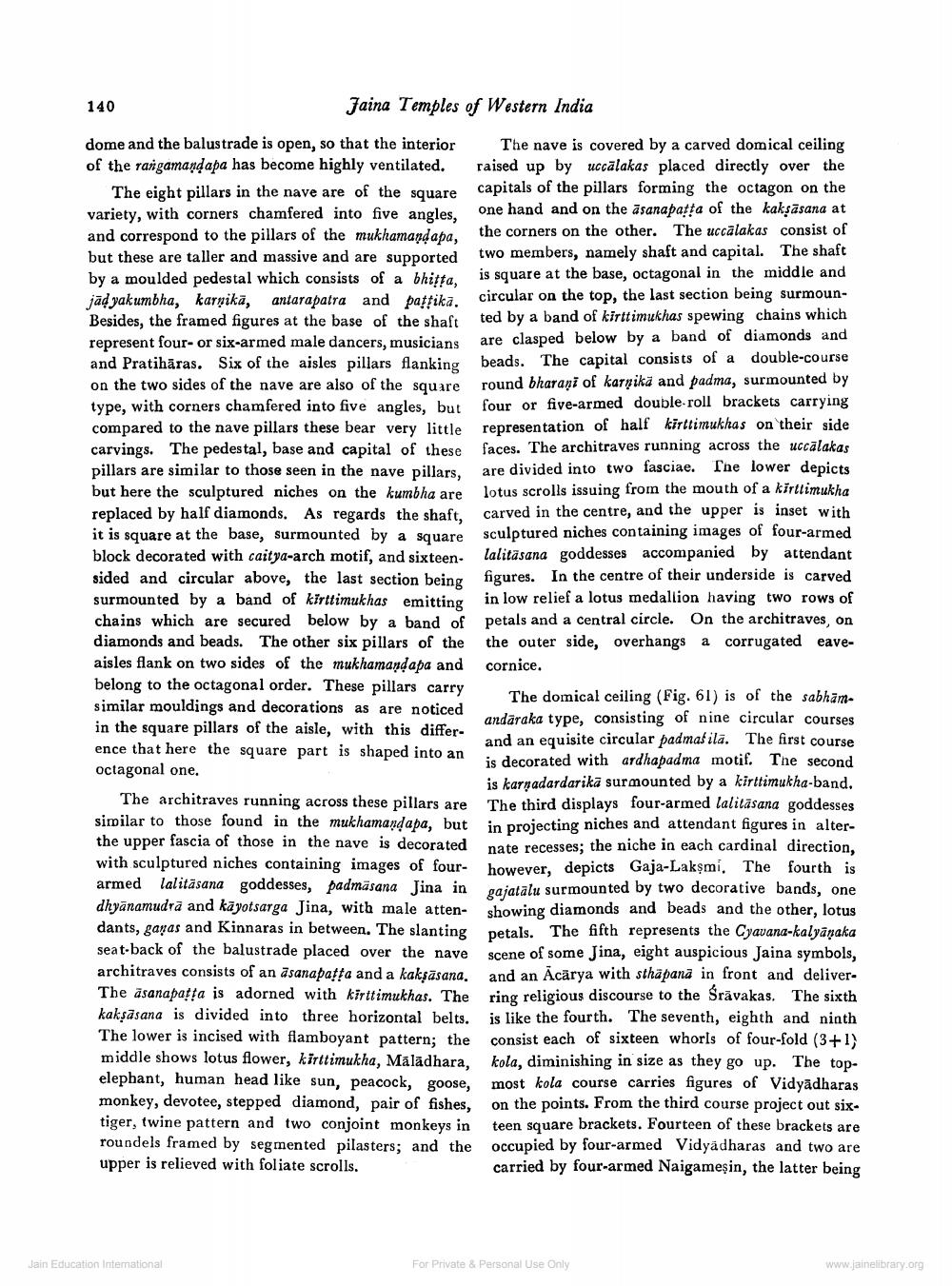________________
140
Jaina Temples of Western India
dome and the balustrade is open, so that the interior of the rangamandapa has become highly ventilated.
The eight pillars in the nave are of the square variety, with corners chamfered into five angles, and correspond to the pillars of the mukhamandapa, but these are taller and massive and are supported by a moulded pedestal which consists of a bhitta, jad yakumbha, karnika, antarapatra and pattika. Besides, the framed figures at the base of the shaft represent four- or six-armed male dancers, musicians and Pratihāras. Six of the aisles pillars flanking on the two sides of the nave are also of the square type, with corners chamfered into five angles, but compared to the nave pillars these bear very little carvings. The pedestal, base and capital of these pillars are similar to those seen in the nave pillars, but here the sculptured niches on the kumbha are replaced by half diamonds. As regards the shaft, it is square at the base, surmounted by a square block decorated with caitya-arch motif, and sixteensided and circular above, the last section being surmounted by a band of kirttimukhas emitting chains which are secured below by a band of diamonds and beads. The other six pillars of the aisles flank on two sides of the mukhamandapa and belong to the octagonal order. These pillars carry similar mouldings and decorations as are noticed in the square pillars of the aisle, with this difference that here the square part is shaped into an octagonal one.
Jain Education International
The nave is covered by a carved domical ceiling raised up by uccalakas placed directly over the capitals of the pillars forming the octagon on the one hand and on the asanapaṭṭa of the kakṣāsana at the corners on the other. The uccalakas consist of two members, namely shaft and capital. The shaft is square at the base, octagonal in the middle and circular on the top, the last section being surmounted by a band of kirttimukhas spewing chains which are clasped below by a band of diamonds and beads. The capital consists of a double-course round bharani of karnika and padma, surmounted by four or five-armed double roll brackets carrying representation of half kirttimukhas on their side faces. The architraves running across the uccalakas are divided into two fasciae. The lower depicts lotus scrolls issuing from the mouth of a kirtlimukha carved in the centre, and the upper is inset with sculptured niches containing images of four-armed lalitäsana goddesses accompanied by attendant figures. In the centre of their underside is carved in low relief a lotus medallion having two rows of petals and a central circle. On the architraves, on the outer side, overhangs a corrugated eavecornice.
The architraves running across these pillars are similar to those found in the mukhamandapa, but the upper fascia of those in the nave is decorated with sculptured niches containing images of fourarmed lalitasana goddesses, padmasana Jina in dhyanamudra and kayotsarga Jina, with male attendants, gagas and Kinnaras in between. The slanting seat-back of the balustrade placed over the nave architraves consists of an asanapaṭṭa and a kakṣāsana. The asanapaṭṭa is adorned with kirttimukhas. The kakṣāsana is divided into three horizontal belts. The lower is incised with flamboyant pattern; the middle shows lotus flower, kirttimukha, Mālädhara, elephant, human head like sun, peacock, goose, monkey, devotee, stepped diamond, pair of fishes, tiger, twine pattern and two conjoint monkeys in roundels framed by segmented pilasters; and the upper is relieved with foliate scrolls.
andaraka type, consisting of nine circular courses The domical ceiling (Fig. 61) is of the sabhamis decorated with ardhapadma motif. The second and an equisite circular padmašila. The first course is karyadardarika surmounted by a kirttimukha-band. The third displays four-armed lalitäsana goddesses in projecting niches and attendant figures in alternate recesses; the niche in each cardinal direction, however, depicts Gaja-Laksmi. The fourth is gajatālu surmounted by two decorative bands, one showing diamonds and beads and the other, lotus petals. The fifth represents the Cyavana-kalyāṇaka scene of some Jina, eight auspicious Jaina symbols, and an Acarya with sthapana in front and deliverring religious discourse to the Śravakas. The sixth is like the fourth. The seventh, eighth and ninth consist each of sixteen whorls of four-fold (3+1) kola, diminishing in size as they go up. The topmost kola course carries figures of Vidyadharas on the points. From the third course project out sixteen square brackets. Fourteen of these brackets are occupied by four-armed Vidyadharas and two are carried by four-armed Naigameşin, the latter being
For Private & Personal Use Only
www.jainelibrary.org




